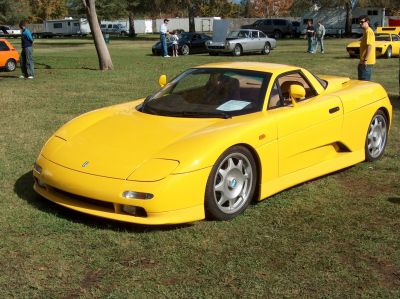 1994 Venturi 400 Dimensions, Size & Specs
1994 Venturi 400 Dimensions, Size & SpecsMeasurements of the 1994 Venturi 400, engineered for optimal performance and comfort
| Dimensions | |
|---|---|
| Length: | 4140 mm163.0 in13.6 ft |
| Width: | 1990 mm78.3 in6.5 ft |
| Height: | 1170 mm46.1 in3.8 ft |
| Weight Specifications | |
| Curb Weight: | 1000-1150 kg2205-2535 lbs |
| Maximal permitted Weight: | 1400 kg3086 lbs |
| Tire Specifications | |
| Tire Sizes: |
|
The Venturi 400, produced from 1994 to 1997, represents a classic French sports coupe known for its aggressive styling and compact yet muscular proportions. Measuring 4140 mm (162.9 inches) in length, 1990 mm (78.3 inches) in width, and standing only 1170 mm (46.1 inches) tall, this vehicle offers a low-slung, aerodynamic silhouette typical of 1990s high-performance coupes. The curb weight of the Venturi 400 ranges from 1000 to 1150 kg (2205 to 2535 lbs), contributing to its nimble handling and dynamic driving experience. Its maximum weight is rated at 1400 kg (3086 lbs), highlighting its lightweight engineering focus. Equipped with a range of wide tires—including sizes 245/40 ZR18, 255/35 ZR18, 235/40 ZR18, and 295/35 ZR18—the Venturi 400 boasts excellent road grip and stability to match its sporty character. This generation of Venturi combined lightweight construction and sharp dimensions to compete effectively in the niche sports car segment of the mid-1990s. Ideal for enthusiasts seeking a unique French coupe, the Venturi 400 balances sporty size with distinctive performance credentials, making it a notable entry in car size comparisons and automotive history.
Discover the standout features that make the 1994 Venturi 400 a leader in its class
Have a question? Please check our knowledgebase first.
The Venturi 400, produced from 1994 to 1997, measures 4140 mm (163 inches) in length, 1990 mm (78.3 inches) in width, and has a low profile height of 1170 mm (46.1 inches). These dimensions give it a distinct, sporty coupe silhouette that emphasizes aerodynamic efficiency and aggressive styling, typical for sports cars of its era.
The Venturi 400 has a curb weight ranging from 1000 kg to 1150 kg (2205 to 2535 pounds), which is relatively light for a high-performance coupe. Its maximum weight is 1400 kg (3086 pounds), allowing for some payload capacity. This lightweight construction enhances its agility and performance, making it competitive with other sports coupes from the mid-1990s.
With a width of 1990 mm (78.3 inches) and a height of only 1170 mm (46.1 inches), the Venturi 400 is quite wide but very low. Most standard residential garages, which are typically about 2440 mm (96 inches) wide and over 2100 mm (82 inches) tall, can accommodate the Venturi 400 comfortably in height, but the width requires careful maneuvering due to its nearly 2-meter width. Overall, it fits in standard garages but with limited clearance on the sides.
The Venturi 400 comes with staggered tire sizes that include 245/40 ZR18 and 285/35 ZR18 on some configurations, and 235/40 ZR18 with 295/35 ZR18 on others. These large, wide tires mounted on 18-inch wheels enhance grip, cornering stability, and overall handling, which is crucial for a high-performance sports coupe aiming to maximize road contact and driving dynamics.
At 4140 mm (163 inches), the Venturi 400 is moderately long for a coupe, offering a good balance between stable high-speed behavior and city maneuverability. Its length is typical for sports models of the era, providing sufficient room for aerodynamic design without compromising agility. This length aids in better handling characteristics, especially during spirited driving or track use.
The low height of 1170 mm (46.1 inches) reduces the car's center of gravity, contributing to improved cornering stability and responsiveness. Aerodynamically, this helps reduce drag and lift at high speeds, enhancing both performance and fuel efficiency. Drivers experience a sporty seating position and superior road feedback, which is typical for performance-focused coupes like the Venturi 400.
The Venturi 400 is an evolution over previous Venturi models, such as the Venturi Atlanta, featuring more aggressive dimensions and improved weight savings. While specific dimensions for predecessors vary, the 400's relatively compact length of 4140 mm and low curb weight (1000-1150 kg) represent a shift toward lighter, more nimble sports cars with enhanced performance. Compared to its predecessors, the 400 offered significant advancements in power delivery, handling, and contemporary styling.
Compared to rivals from the mid-1990s, such as the Ferrari 355 or Porsche 911 (993), the Venturi 400 is similar in length but generally wider and has a notably lower height, emphasizing a more aggressive stance. Its curb weight between 1000 kg and 1150 kg places it among the lighter sports coupes, which boosts performance metrics. This combination of size and weight makes it competitive in agility and speed with leading sports cars of that era.
With a maximum weight of 1400 kg (3086 pounds) and a curb weight of 1000-1150 kg, the Venturi 400 can carry approximately 250-400 kg (551-881 pounds) of combined passengers and cargo safely. While designed primarily as a sports coupe with a performance focus, this capacity allows for limited practicality in daily use, such as two passengers and some luggage, but it's not ideal for heavy loads or large families.
The Venturi 400 distinguishes itself through its bold French design which includes wide-body proportions and an extremely low profile at 1170 mm height. It features aerodynamic sculpting for optimized airflow, combined with large, performance-oriented tires that enhance grip and stability. Additionally, its lightweight construction and engineered balance provide a driving experience that blends raw power with refined handling, making it a unique and collectible sports coupe of the 1990s.
Discover similar sized cars.

| Production: | 1993-2001 |
|---|---|
| Model Year: | 1993 |
| Length: | 4190 mm165.0 in |
| Width: | 2030 mm79.9 in |
| Height: | 1200 mm47.2 in |
